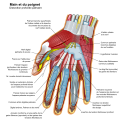Vaizdas:Wrist and hand deeper palmar dissection-numbers.svg

Rinkmenos SVG peržiūros PNG dydisː 474 × 600 taškų. Kitos 6 rezoliucijos: 190 × 240 taškų | 379 × 480 taškų | 607 × 768 taškų | 809 × 1 024 taškų | 1 619 × 2 048 taškų | 555 × 702 taškų.
Didesnės raiškos iliustracija (SVG rinkmena, formaliai 555 × 702 taškų, rinkmenos dydis: 207 KiB)
Rinkmenos istorija
Paspauskite ant datos/laiko, kad pamatytumėte rinkmeną tokią, kokia ji buvo tuo metu.
| Data/Laikas | Miniatiūra | Matmenys | Naudotojas | Paaiškinimas | |
|---|---|---|---|---|---|
| dabartinis | 20:15, 1 birželio 2015 |  | 555 × 702 (207 KiB) | Perhelion | optimize image |
| 14:42, 8 liepos 2012 |  | 555 × 702 (399 KiB) | Wilfredor | optimize image | |
| 00:11, 14 sausio 2009 |  | 555 × 702 (817 KiB) | Wilfredor | {{Information |Description= |Source= |Date= |Author= |Permission= |other_versions= }} | |
| 19:37, 16 spalio 2008 |  | 555 × 702 (815 KiB) | Wilfredor | {{Information |Description= |Source= |Date= |Author= |Permission= |other_versions= }} | |
| 22:33, 23 liepos 2008 |  | 770 × 767 (822 KiB) | Bibi Saint-Pol | {{Created with Inkscape}} == {{int:filedesc}} == {{Information |Description= {{en|The hands (med./lat.: manus, pl. manūs) are the two intricate, prehensile, multi-fingered body parts normally located at the end of each arm of a human or other primate. Th |
Paveikslėlio naudojimas
Paveikslėlis yra naudojamas šiuose puslapiuose:
Visuotinis rinkmenos naudojimas
Ši rinkmena naudojama šiose viki svetainėse:
- Naudojama af.wikipedia.org
- Naudojama ar.wikipedia.org
- Naudojama az.wikipedia.org
- Naudojama bjn.wikipedia.org
- Naudojama bn.wikipedia.org
- Naudojama br.wikipedia.org
- Naudojama ce.wikipedia.org
- Naudojama crh.wikipedia.org
- Naudojama cv.wikipedia.org
- Naudojama da.wikipedia.org
- Naudojama de.wikipedia.org
- Naudojama en.wikipedia.org
- Wikipedia:Featured picture candidates/Wrist and hand deeper palmar dissection-en.svg
- Wikipedia:Featured picture candidates/April-2009
- User:Madhero88/Medicalg
- Wikipedia:WikiProject Anatomy/Resources
- Wikipedia talk:WikiProject Anatomy/Archive 9
- User talk:Rhododendrites/Reconsidering FPC on the English Wikipedia
- Naudojama es.wikipedia.org
- Naudojama fa.wikipedia.org
- Naudojama fr.wikipedia.org
- Naudojama hr.wikipedia.org
- Naudojama hu.wikipedia.org
- Naudojama id.wikipedia.org
- Naudojama incubator.wikimedia.org
- Naudojama iu.wikipedia.org
- Naudojama ko.wikipedia.org
- Naudojama lbe.wikipedia.org
- Naudojama lb.wikipedia.org
- Naudojama ms.wikipedia.org
- Naudojama nia.wiktionary.org
- Naudojama os.wikipedia.org
- Naudojama pl.wikipedia.org
- Naudojama pt.wikipedia.org
- Naudojama ru.wikipedia.org
Žiūrėti visuotinį šios rinkmenos naudojimą.








